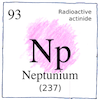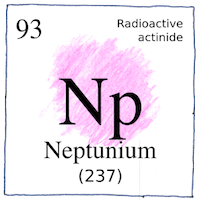Berkeley—Edwin McMillan,
Philip Abelson
elements

|
Neptunium
Dmitri Mendeleev left a place for it after uranium. Enrico Fermi bombarded uranium with neutrons and thought he made it, but he was probably seeing the results of splitting uranium atoms. Edwin McMillan began producing stuff with a cyclotron having a unique half-life of 2.3 days, and tried to isolate it, but the actinide series after radium hadn’t been established, so chemists were hampered by the mistaken assumption that element 93 would be chemically like rhenium. McMillan asked Philip Abelson to work with him on it. They found it was more like uranium than a rare earth and proved that element 93 was produced by decay of uranium.
Atomic number 93
Neptunium is radioactive, poisonous, bioaccummulative, and a fire hazard. Nuclear power plants create isotopes with long half-lives, and we have no solution for storing this waste for thousands of years.
Pandora’s stuff
It’s been interesting, but there’s no way to put it back into its box.



Neptunium is not an evil inflicted upon mankind; it is an evil that mankind has inflicted upon itself. It is also the precursor to the production of plutonium, which provided the fissile core of the bomb dropped on Nagasaki.
See also in The book of science:
Readings in wikipedia:
Other readings: